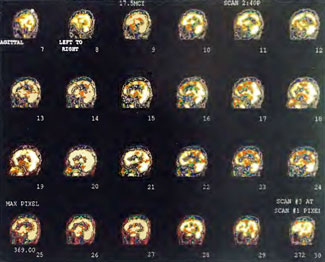Researchers Report Successful Treatment of Chronic TBI
ARLINGTON, Va., Oct. 11, 2007 — The American Association of Health Freedom and the International Hyperbaric Medical Association announced today [10-12-07] that physician-researchers at the Baromedical Research Institute and Louisiana State University School of Medicine, New Orleans have reported the successful treatment of chronic traumatic brain injury (TBI). The findings, published in Brain Research (2007 Oct 12;1174:120-9), are purportedly the first-ever demonstration of improvement of chronic brain injury in animals. The treatment involved a new application and drug dosage of hyperbaric oxygen therapy (HBOT). Hyperbaric oxygen therapy is the application on 100% oxygen while in a pressurized chamber. HBOT has been applied to diving injuries, carbon monoxide poisoning, “flesh-eating bacteria,” and chronic wounds. Application to chronic brain injury is controversial. This demonstration is a landmark achievement that shows chronic brain injury rehabilitation to some extent can be achieved. It has significant implications for the treatment of chronic human traumatic brain injury (TBI) such as for current U.S. military veterans, and sports concussions.
Lead author, Paul G. Harch, M.D., Clinical Assistant Professor, Director of the LSU School of Medicine Hyperbaric Medicine Fellowship in New Orleans, and author of recently published The Oxygen Revolution (Hatherleigh Press, NY), said that he made this discovery when he first applied HBOT to divers with a disabling form of “the bends,” brain decompression illness. Harch noticed that the traditional application of a single HBOT to freshly injured divers did not result in the immediate cure described by the U.S. Navy. Instead, divers from the Gulf of Mexico presented days to weeks after their injury and required much more HBOT at a lower pressure. Eventually, he realized that they were treating more chronic forms of brain injury since the bubbles had long passed through the divers’ brains. Harch and colleagues applied this lower dose of HBOT to patients with other forms of chronic brain injury, including trauma, cerebral palsy, autism, toxic brain injury, dementia, and multiple other diagnoses.
Harch stated that when he presented this human case experience at scientific meetings from 1992 to 1999 he was criticized for lack of an animal model. As a result, he adapted the Feeney model of acute traumatic brain injury to chronic brain injury and applied his human protocol of HBOT. Harch and colleagues were able to show in Brain Research that they could improve cognition (spatial learning and memory) while increasing blood vessel density in the damaged hippocampus of the rats.
The potential application to chronic human TBI is important because there is currently no treatment. Chronic TBI affects over 5 million Americans. Costs of treating TBI exceed $60 billion/year in the U.S. alone. The personal toll is far greater. Traumatic brain injury has also been described as the signature injury of the wars in Iraq and Afghanistan. As many as 400,000 U.S. servicemen have been exposed to blast injuries and could have varying degrees of TBI. Application of HBOT to these veterans could have a significant impact on their return to work, quality of life, and national security. For information on the Brain Injury Rescue and Rehabilitation Project, please visit
Brenna Hill, AAHF
[email protected]

